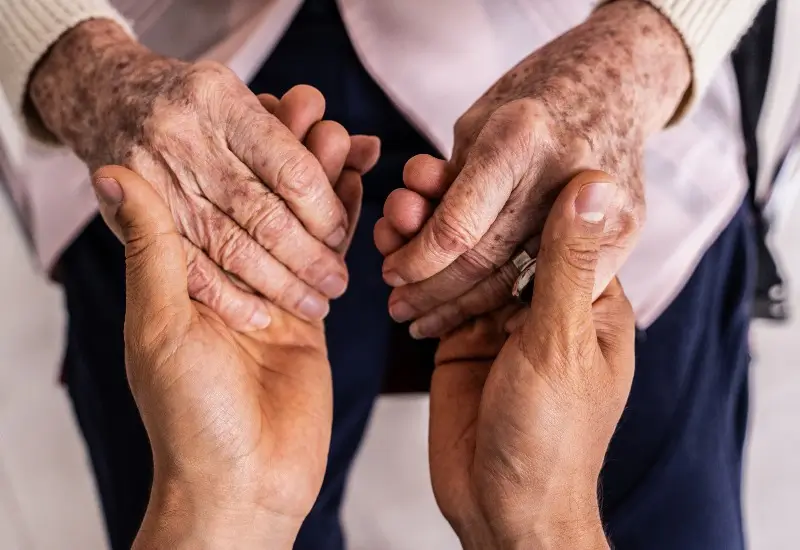How Long Can a Hospice Patient Live Without Food?

At Agape Hospice & Palliative Care, we help families through one of life’s most challenging experiences—the passing of a loved one. When a family member enters hospice care, lots of questions come up related to their well-being. Sometimes people ask us about their loved one’s comfort, while others wonder if their loved one could live longer than six months. But most often, we’re asked how long someone can live without food on hospice. The answer to this question is more complex than you might think. With this in mind, here’s what you need to know about the lack of appetite and hospice care in Los Angeles and Orange County.
Why Does Appetite Decrease at the End of Life?
As a person nears the end of their life, their appetite will naturally decrease. While this is a completely normal process, it’s still heartbreaking to watch a loved one stop eating. The team at Agape is here to help you understand the decrease in appetite and what is going on with your loved one’s condition. As someone enters the dying process, these changes are likely to occur:
- Reduced Energy Demand—In the final stages of hospice care, the body slows down and no longer requires as much energy. Organs like the liver and kidneys may begin to function less efficiently, and movement becomes limited.
- Difficulty Swallowing—Dysphagia, or difficulty swallowing, often develops in hospice patients. This condition makes eating feel uncomfortable or even dangerous due to the risk of choking.
- Focus of Care Shifts—Hospice care prioritizes comfort and quality of life over sustaining caloric intake or artificially prolonging life. In many cases, physicians advise against force-feeding or the use of feeding tubes, as these interventions can cause distress or discomfort.
What Influences How Long a Patient Can Live Without Food?
The human body is incredibly resilient, and the survival time for someone who stops eating is influenced by many factors. Here are a few factors that may determine how long without food or water a hospice patient live:
- Hydration—Dehydration usually has a more immediate impact on health than a lack of food. Hospice care providers often focus on keeping patients comfortable through small sips of water, ice chips, or even moistening the mouth with swabs.
- Underlying Health Conditions—Your loved one’s overall health and medical history play a significant role in how long they can live. If they were well-nourished before entering hospice, they may live longer than average.
- Body Fat and Muscle—Stored fat and muscle mass provide critical energy when the person is no longer eating. If your loved one has more physical reserves, they may sustain themselves for a longer period of time.
- Rest Time—Resting bodies require less energy. Those who cannot move much in hospice care may live slightly longer without food than someone more active.
Timeframe After Someone Stops Eating
Every person in hospice is different, but we can make a general estimate of how long someone can live after the removal of a feeding tube. Here are some typical timeframes:
- Hospice patients who are hydrated but cannot eat may live between 10 and 21 days.
- Those who don’t consume food or water usually only live for another three to 10 days.
- Psychological and spiritual factors may also influence this timeframe. Some patients seem to hold on until they sense their family is ready to cope or a specific event happens, such as a loved one arriving to say goodbye.
Supporting a Loved One When They Stop Eating
It’s natural for caregivers to feel worry or even guilt when a loved one stops eating. After all, offering food is such a universal way of showing love. However, remind yourself that declining to eat is part of the natural progression, not a signal of neglect. While you can’t force your loved one to eat, you can still provide immense comfort in these ways:
- Help Them Hydrate—Even small amounts of fluids can reduce discomfort. Encourage sips of water, offer ice chips, or use a sponge to moisten their lips.
- Prioritize Comfort—Soft blankets, room temperature control, and calming music can create a more peaceful atmosphere.
- Speak and Be Present—Even if a loved one is unresponsive, your voice can be soothing. Talk softly, hold their hand, or simply sit quietly by their side.
Compassionate Hospice Care in Los Angeles
Understanding how long someone can live without food in hospice is only one way to make the transition easier. The team at Agape Hospice & Palliative Care is here to answer your questions about feeding, as well as address concerns about pain medication, comfort, and bereavement. Contact us today to learn more about the benefits of hospice.


